Conserving and celebrating an ancient fish
McKayla Lee
Underscore News

To close the Willamette Falls Lamprey Celebration on July 30, 2022, participants from the crowd were encouraged to dance together to the beat of the drum in a social dance called the “eel dance” that honored the lamprey eaten that day. Photo by McKayla Lee/Underscore News
Tribes come together at Willamette Falls to celebrate the annual harvest of Pacific Lamprey, a first of of Native peoples in the Pacific Northwest, in the midst of ongoing tribal conservation efforts
An ancient fish has been swimming in the waters of the Pacific Northwest since before trees existed. After surviving for hundreds of millions of years, Pacific lamprey were decimated by dams and other human-caused habitat disruptions, as well as lack of government protections. Tribes are leading conservation efforts, with the goal of getting their numbers back to levels that ensure a reliable harvest.
On a hot afternoon in July, members of the Yakama Nation and the Confederated Tribes of Warm Springs celebrated their first foods with a feast. The tribes held the event near Willamette Falls, where, that morning, tribal members had gathered the lamprey they served. The celebration was open to the public and featured a full day of drumming, dancing and feasting.
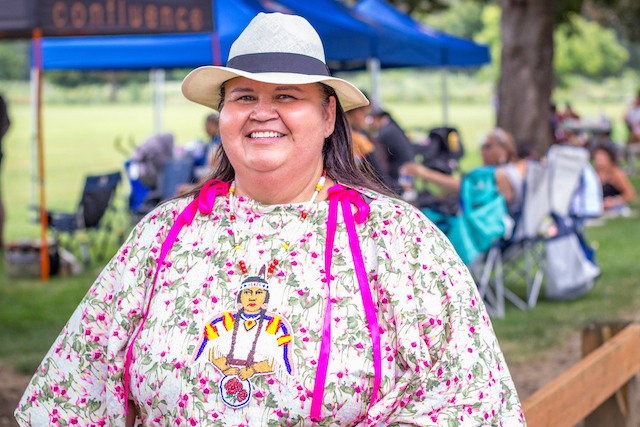
“We organized this event to honor and celebrate our annual lamprey harvest,” said Donella Miller, Yakama Nation Fisheries biologist and program manager. “We normally have feasts to honor the foods back at our longhouses at home, but we haven’t had anything down here on our ancestral lands since the 1990s. It was important to us to come back and share these teachings with our young ones, to pass on traditions.”
Pacific lamprey play key roles in tribal culture and ecology. Among the oldest fish in the world, they have been around for over 450 million years and even predate dinosaurs. The eel-like fish are anadromous and have unique physical characteristics, including having no jaws or bones, although they have a mouth full of teeth.
Lamprey spend their early years nestled in the sediment of creek beds as blind filter feeders. They transform into parasitic adults when they’re between three and seven years old, then migrate to the ocean to feed on bigger fish and grow for years before returning to spawn in the freshwater of rivers and creeks, to which they are drawn by the pheromones of other lamprey.
The fish are a traditional food source for the Columbia River Basin’s Indigenous people, as well as a culturally important species for medicine and ceremony.
“Lamprey are kind of like river gold, their oil content is so high, which makes them a high-nutrient food,” Miller said. “And their oils also have medicinal purposes. You can use that for earaches and even for your skin.”
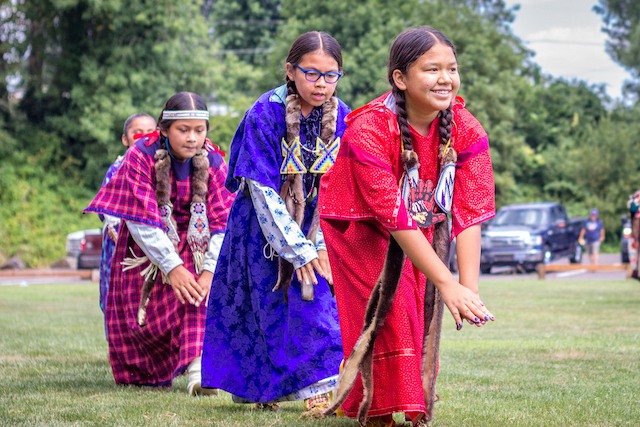
Over time, once-abundant lamprey populations declined. Populations above dams and in the rivers and streams that flow into the Columbia River are functionally extinct, meaning that so few make it to those places that they can no longer play their ecological role there. Passages at dams designed for salmon were nearly impossible for lamprey to navigate, while their spawning beds were spoiled by poor water quality. And their high fat volume made them the perfect prey for birds. Lamprey have always fed many species, and their former abundance took predation pressure off salmon and steelhead. Now, that same longstanding predator-prey relationship is much more harmful to today’s tiny populations of lamprey.
For decades, the government treated Pacific lamprey as unworthy of protection or restoration. But the tribes never stopped pushing for their recovery. The Columbia River Inter-Tribal Fish Commission (CRITFC) created the Tribal Pacific Lamprey Restoration Plan in 2001. This tribal-led initiative is the most comprehensive plan to reestablish the lamprey population. CRITFC has been committed to protecting tribal treaty fishing rights and conserving and sharing fish culture since its founding in 1977. The organization helps coordinate fish restoration for the Yakama, Warm Springs, Umatilla, and Nez Perce tribes.
CRITFC Lamprey Biologist Laurie Porter said that one of the biggest issues lamprey face is passage at the dams, which nearly wipes out returning adults by the time they reach the Lower Snake River. Too few lamprey make it past the final Snake River dam to sustain that watershed’s population.
“On average, only a few hundred pass through Lower Granite Dam — and that’s basically extirpated, there’s no other way to say it,” Porter said.
In 2008, the Yakama Nation launched its Pacific Lamprey Project to restore lamprey in the nation’s ceded lands and in the tribe’s usual and accustomed areas. The plan is intended to complement CRITFC efforts.
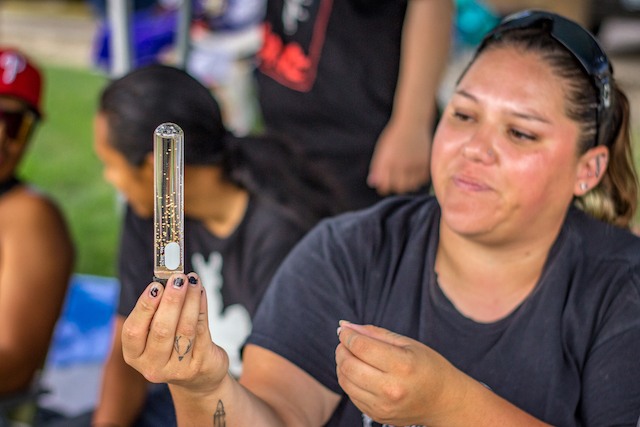
“We harvested lamprey in a sustainable manner, taking only what we needed for subsistence,” said Davey Lumley, a biologist with Yakama Nation Fisheries. “We depended on them for food and medicine back when lamprey were plentiful, but due to various factors this is no longer the case. Our goal now is to restore natural production of lamprey to a level that will once again provide abundance.”
The Pacific Lamprey Project installed “lamprey slides” to help the fish get past the dams in the Columbia River Basin. The U.S. Army Corps of Engineers designed the original fish ladders so that salmon and steelhead could jump up to the reservoirs behind the dams through successive small pools, like a series of waterfalls.
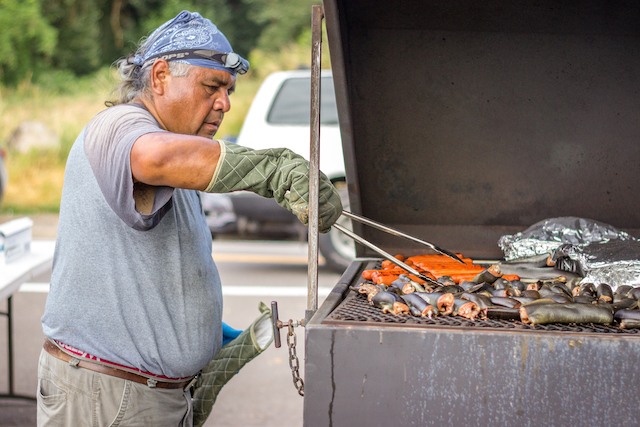
But lamprey are weak swimmers and are unable to jump, so they need a vertical surface they can suction onto in order to climb their way through.
“It’s difficult enough for salmon to get through but for lamprey it’s nearly impossible,” Miller said.
Lumley said the project started by installing the slides at Bonneville Dam, on the Columbia River. Now, tribal biologists are adding slides to help lamprey pass dams on smaller tributaries, so the fish can get back to more of the places where Native people once collected them.
The project is guided by traditional ecological knowledge.
“We want to work with elders to compare where lamprey were historically found versus where they are now,” Lumley said.
Once they have identified those spots, the project can reintroduce them. The fish themselves will help out, too.
“Pacific lamprey are not like salmon,” Lumley said. “Lamprey are attracted to pheromones of other lamprey, so by us putting lamprey into streams of low population it attracts more wild lamprey to go there.”
In addition to traditional ecological knowledge, new technology will help support elders’ knowledge of lamprey migration. Tiny tracking devices will provide new insights to help guide conservation efforts.
The Willamette Falls Lamprey Celebration is undergoing its own restoration. The July 30 event was the first celebration held in this spot by the Yakama and Warm Springs nations for over 30 years, offering a time for the community to gather and commemorate the natural and cultural resources they have protected since time immemorial.
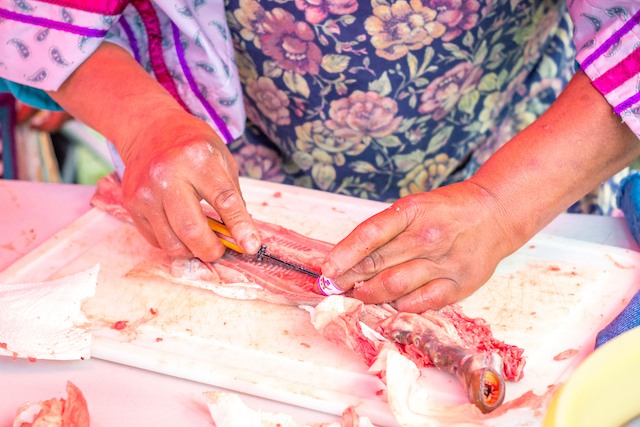
Tribal leaders and community members made it clear that the tribes will continue to work together to engage, protect and restore their rights and resources for current and future generations of their people.
“Tribes have always been at the forefront of ensuring that these resources persist for future generations,” Miller said.
She added that the celebration will continue, too.
“Carrying on this way of life and our teachings for the people has been an honor,” Miller said. “We opened this event to the public to welcome and share these good feelings. The land and the foods were good medicine for everyone who was in attendance.”
McKayla Lee attends the University of Montana and is the inaugural recipient of the Underscore Indigenous Journalism Fellowship.

